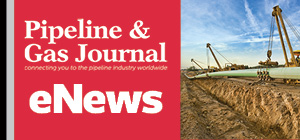Report: Growth in Oil Sands Projects Drives Need for More Pipelines in Canada
6/14/2017

Canada will need more pipelines built through to 2030 to transport an additional 1.3 million barrels per day of oil sands production to markets across North America and around the world, the Canadian Association of Petroleum Producers has announced in its “2017 Crude Oil Forecast, Markets and Transportation” report.
Key findings from the report include:
- Overall Canadian oil production will grow to 5.1 million b/d in 2030, up from 3.85 million b/d in 2016. This 1.3-million-b/d growth will be driven by a 53-percent increase in forecasted oil sands production of up to 3.7 million b/d in 2030 from 2.4 million b/d in 2016.
- Conventional oil production is expected to remain flat, producing 884,000 b/d on average throughout the outlook.
- New offshore production from the Hebron project in Newfoundland and Labrador, expected at the end of 2017, will contribute to a rise in eastern Canadian output to 307,000 b/d by 2024, but thereafter, due to natural declines, forecasted production will drop to 186,000 b/d by 2030.
- Projected growth will exceed the existing pipeline transportation capacity, highlighting the urgent need for pipelines heading east, west, and south. Today, the pipeline network can transport 4 million b/d of oil and oil products, but, by 2030, it will need to move more than 5.5 million b/d. Increased pipeline capacity to reach more Canadians and new, growing markets around the world will ensure Canada remains globally competitive.
- Capital spending in the oil sands is expected to decline for the third consecutive year to $15 billion in 2017 from $34 billion in 2014. Drilling by conventional crude oil producers is forecast to increase 70 per cent compared to 2016 levels, but will still be 40 per cent lower than in 2014.
- At present, Canada’s oil industry faces a number of challenges tempering long-term growth prospects, including uncertainty related to provincial and federal climate change policies in Canada, potential protectionist policies in the U.S., and diverging regulatory efficiencies between Canada and the U.S. Among its biggest challenges continues to be pipeline constraints. In the past year pipelines such as the Trans Mountain Expansion Project, Enbridge Line 3, and Keystone XL have been approved and, when built, will provide much-needed pipeline capacity to access North American and Asian markets. However, Energy East – a portal connecting Canada to Europe and beyond – is still needed to further connect Canada’s growing supplies to diverse markets.
Related News
Related News
Sign up to Receive Our Newsletter

- Kinder Morgan Proposes 290-Mile Gas Pipeline Expansion Spanning Three States
- Valero Plans to Shut California Refinery, Takes $1.1 Billion Hit
- Three Killed, Two Injured in Accident at LNG Construction Site in Texas
- Tallgrass to Build New Permian-to-Rockies Pipeline, Targets 2028 Startup with 2.4 Bcf Capacity
- TC Energy Approves $900 Million Northwoods Pipeline Expansion for U.S. Midwest
- U.S. Pipeline Expansion to Add 99 Bcf/d, Mostly for LNG Export, Report Finds
- Enbridge Adds Turboexpanders at Pipeline Sites to Power Data Centers in Canada, Pennsylvania
- Great Basin Gas Expansion Draws Strong Shipper Demand in Northern Nevada
- Cheniere Seeks FERC Approval to Expand Sabine Pass LNG Facility
- Heath Consultants Exits Locate Business to Expand Methane Leak Detection Portfolio
Pipeline Project Spotlight
Owner:
East African Crude Oil Pipeline Company
Project:
East African Crude Oil Pipeline (EACOP)
Type:
TotalEnergies in discussions with a Chinese company after Russian supplier Chelpipe was hit by sanctions.
Length:
902 miles (1,443 km)
Capacity:
200,000 b/d
Start:
2022
Completion:
2025




Comments